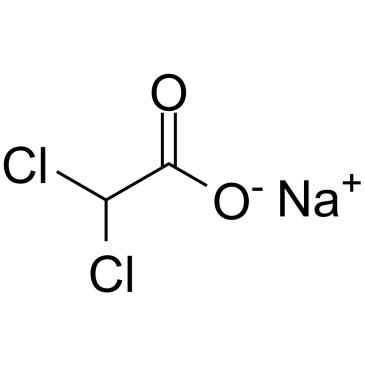Sodium Dichloroacetate

Sodium Dichloroacetate structure
|
Common Name | Sodium Dichloroacetate | ||
|---|---|---|---|---|
| CAS Number | 2156-56-1 | Molecular Weight | 150.924 | |
| Density | N/A | Boiling Point | 194ºC at 760mmHg | |
| Molecular Formula | C2HCl2NaO2 | Melting Point | 198 °C (dec.)(lit.) | |
| MSDS | Chinese USA | Flash Point | N/A | |
| Symbol |


GHS07, GHS08 |
Signal Word | Warning | |
|
Dual-targeting of aberrant glucose metabolism in glioblastoma.
J. Exp. Clin. Cancer Res 34 , 14, (2015) Glioblastoma (GBM) is the most common and malignant primary brain tumor. In contrast to some other tumor types, aberrant glucose metabolism is an important component of GBM growth and chemoresistance. Recent studies of human orthotopic GBM in mice and in situ... |
|
|
A Korean female patient with thiamine-responsive pyruvate dehydrogenase complex deficiency due to a novel point mutation (Y161C)in the PDHA1 gene.
J. Korean Med. Sci. 21 , 800-4, (2006) Pyruvate dehydrogenase complex (PDHC) deficiency is mostly due to mutations in the X-linked E1alpha subunit gene (PDHA1). Some of the patients with PDHC deficiency showed clinical improvements with thiamine treatment. We report the results of biochemical and ... |
|
|
Sensitization of Glioblastoma Cells to Irradiation by Modulating the Glucose Metabolism.
Mol. Cancer Ther. 14 , 1794-804, (2015) Because radiotherapy significantly increases median survival in patients with glioblastoma, the modulation of radiation resistance is of significant interest. High glycolytic states of tumor cells are known to correlate strongly with radioresistance; thus, th... |
|
|
Bioenergetic modulation with dichloroacetate reduces the growth of melanoma cells and potentiates their response to BRAFV600E inhibition.
J. Transl. Med. 12 , 247, (2014) Advances in melanoma treatment through targeted inhibition of oncogenic BRAF are limited owing to the development of acquired resistance. The involvement of BRAFV600E in metabolic reprogramming of melanoma cells provides a rationale for co-targeting metabolis... |
|
|
Bicarbonate and dichloroacetate: evaluating pH altering therapies in a mouse model for metastatic breast cancer.
BMC Cancer 11 , 235, (2011) The glycolytic nature of malignant tumors contributes to high levels of extracellular acidity in the tumor microenvironment. Tumor acidity is a driving force in invasion and metastases. Recently, it has been shown that buffering of extracellular acidity throu... |
|
|
Novel N-phenyl dichloroacetamide derivatives as anticancer reagents: design, synthesis and biological evaluation.
Eur. J. Med. Chem. 45 , 4300-6, (2010) A current study shows that sodium dichloroacetate (DCA) can induce cancer cell apoptosis and inhibit tumor growth, but its cytotoxic activity is low (IC(50) > 1000 microM for A549). In this paper, a variety of DCA derivatives were synthesized, and their cytot... |